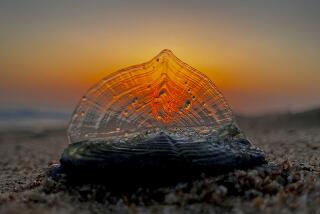New seabird species discovered
Reporting from San Diego — Bird watchers on Friday were following what for them is the event of a lifetime: the discovery of a new species of seabird.
The existence of the sparrow-sized black-and-white species of storm petrel was confirmed in February near the coastal community of Puerto Montt, Chile, according to noted ornithologist Peter Harrison, who announced the find during a ceremony hosted by the San Diego Bird Festival/Audubon California Assembly in San Diego.
“If we had won the lottery, we could not feel better,” Harrison said in an interview.
The discovery marks the first identification of a new species of petrel in 89 years and the first new species of seabird in 55 years, said Harrison, author of “Seabirds: A Complete Guide to the Seabirds of the World.”
“We believe this is a relic population that was completely missed by Darwin himself,” Harrison said. “And guess what? There are thousands of them in an area which is plied by cruise ships, cargo vessels and fishing boats, all within sight of crowded beaches.”
Researchers at the University of Chile in Santiago are analyzing collected blood samples and feathers to learn more about the birds, such as where they breed and if they migrate to wintering grounds elsewhere. Their studies will also provide the basis for a scientific description of the new species and eventually a formal name.
“Important discoveries usually happen in remote places like Borneo or the Amazon forests,” said Garry George, chapter network director for Audubon California. “Not this time. This bird has been under everyone’s noses in a popular area for decades.”
There are 22 other known species of storm petrels, regarded as “the ballerinas of the sea.” Pushing off with webbed feet and spread wings, they seem to dance on the water as they snatch small organisms from the surface.
“It would appear that I was the first to see the new species back in 1983,” said Harrison, who photographed the bird. “I realized at the time that there was something distinct about it, but even my own field guide was not good enough to determine exactly what it was.”
Harrison said he saw the bird off and on over the next five years, and thought it seemed to match descriptions of a small race of Wilson’s storm petrel known locally as the Fuegian storm petrel.
All that changed with the publication of photographs of the mysterious storm petrel taken from a Puerto Montt ferry in 2009 by Irish birders Seamus Enright and Michael O’Keeffe. Those photographs revealed that the birds had prominent white wing bars and far more white on their underparts than the Wilson’s.
They also resembled two storm petrel skins, which had been collected earlier in Argentina and remained unidentified for many years in a natural history museum in Buenos Aires.
Harrison said he flew to Argentina to inspect the skins and noted that they appeared to match the birds seen flying over Puerto Montt. Assuming that the birds were probably new to science, Harrison and others returned to Chile to collect and measure the seabirds and gather feathers and blood samples for DNA testing.
“We chummed for the birds by creating an oil slick of cut-up salmon and cod liver oil,” Harrison said. “Sometimes we had 300 to 400 of these sensational, dainty birds flying around us at one time.”
Members of the expedition stayed in a small complex of cabins marked by a sign featuring hand-painted black-necked swans.
“The owner of the cabins recently told me he plans to repaint the sign with storm petrels,” Harrison said. “He also plans to rename his site Tormenta, the local term for bird of the storm.”
More to Read
Sign up for Essential California
The most important California stories and recommendations in your inbox every morning.
You may occasionally receive promotional content from the Los Angeles Times.











